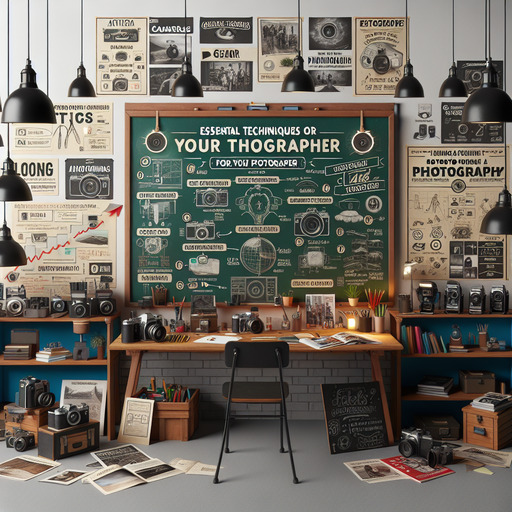
-
Table of Contents
- Mastering Photography: Essential Tips and Techniques for Every Photographer
- Understanding the Basics of Photography
- Photography Gear: Choosing the Right Equipment
- Photography Lighting: Mastering Light for Perfect Shots
- Advanced Photography Techniques
- Portrait Photography: Capturing the Essence of Your Subject
- Landscape Photography: Capturing Nature’s Beauty
- Editing and Post-Processing
- Photography Editing: Enhancing Your Images
- Building a Photography Business
- Photography Services: Offering Professional Solutions
- Conclusion
- Questions and Answers
Mastering Photography: Essential Tips and Techniques for Every Photographer
Photography is more than just capturing moments; it’s about telling stories, evoking emotions, and creating art. Whether you’re a budding photographer or a seasoned professional, understanding the nuances of photography can elevate your work to new heights. In this guide, we’ll explore essential photography tips and techniques that can enhance your skills and help you capture stunning images.
Understanding the Basics of Photography
Photography Gear: Choosing the Right Equipment
Investing in the right photography gear is crucial for capturing high-quality images. While the camera is the heart of your setup, lenses, tripods, and other accessories play a significant role in the outcome of your photos.
- Cameras: Consider your needs—DSLRs offer versatility, while mirrorless cameras are compact and lightweight.
- Lenses: Prime lenses are great for portraits, while zoom lenses offer flexibility for various scenes.
- Tripods: Essential for stability, especially in low-light conditions or long exposure shots.
For example, a landscape photographer might prioritize a wide-angle lens and a sturdy tripod, while a portrait photographer might invest in a high-quality prime lens for sharp, detailed images.
Photography Lighting: Mastering Light for Perfect Shots
Lighting is a critical element in photography. Understanding how to manipulate natural and artificial light can dramatically improve your photos.
- Natural Light: The golden hour, just after sunrise or before sunset, offers soft, warm lighting ideal for portraits and landscapes.
- Artificial Light: Use reflectors and diffusers to control shadows and highlights in studio settings.
- Flash Photography: Mastering flash can help in low-light situations and add creative effects to your images.
Consider the work of renowned photographers who use light creatively, such as Annie Leibovitz, known for her dramatic and evocative portraits.
Advanced Photography Techniques
Portrait Photography: Capturing the Essence of Your Subject
Portrait photography is about more than just taking a picture of someone; it’s about capturing their personality and essence.
- Composition: Use the rule of thirds to position your subject off-center for a more dynamic image.
- Background: Ensure the background complements the subject without being distracting.
- Interaction: Engage with your subject to make them comfortable and capture genuine expressions.
Consider the work of Steve McCurry, whose iconic portrait “Afghan Girl” is a testament to the power of capturing emotion and story in a single frame.
Landscape Photography: Capturing Nature’s Beauty
Landscape photography requires patience and an eye for detail. It’s about capturing the vastness and beauty of nature.
- Timing: Early mornings and late afternoons provide the best lighting conditions.
- Perspective: Experiment with different angles and heights to find unique compositions.
- Filters: Use polarizing filters to enhance colors and reduce reflections.
Photographers like Ansel Adams have set the standard for landscape photography with their breathtaking images of natural wonders.
Editing and Post-Processing
Photography Editing: Enhancing Your Images
Editing is an essential part of the photography process. It allows you to enhance your images and bring your creative vision to life.
- Software: Tools like Adobe Lightroom and Photoshop offer powerful editing capabilities.
- Techniques: Adjust exposure, contrast, and saturation to enhance your images.
- Consistency: Develop a consistent editing style to create a cohesive portfolio.
For instance, many photographers use presets in Lightroom to maintain a consistent look across their work, ensuring their portfolio is both professional and visually appealing.
Building a Photography Business
Photography Services: Offering Professional Solutions
Turning your passion for photography into a business requires more than just technical skills. It involves marketing, client relations, and business acumen.
- Portfolio: Showcase your best work to attract potential clients.
- Networking: Build relationships with other professionals in the industry.
- Marketing: Utilize social media and online platforms to reach a wider audience.
Consider the success stories of photographers who have built thriving businesses by offering unique services and maintaining strong client relationships.
Conclusion
Photography is a journey of continuous learning and exploration. By mastering the basics, experimenting with advanced techniques, and honing your editing skills, you can create stunning images that captivate and inspire. Whether you’re capturing portraits, landscapes, or building a photography business, the key is to keep learning and pushing the boundaries of your creativity.
For more insights into photography techniques and tips, you can explore this Wikipedia page on Photography.
Questions and Answers
Q1: What is the best time of day for landscape photography?
A1: The best time for landscape photography is during the golden hour, which occurs just after sunrise and before sunset. The lighting is soft and warm, creating beautiful shadows and highlights.
Q2: How can I make my portrait subjects feel more comfortable?
A2: Engage in conversation, give clear directions, and create a relaxed environment. Building rapport with your subject can lead to more natural and genuine expressions.
Q3: What are some essential editing tools for photographers?
A3: Adobe Lightroom and Photoshop are popular editing tools among photographers. They offer a wide range of features for adjusting exposure, color, and composition to enhance your images.
If you’re interested in learning more about photography or exploring our services, please reach out to us via our contact page.